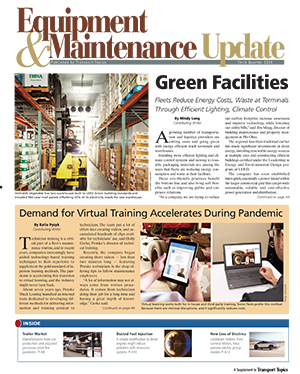The Power of Automatic Braking
[Stay on top of transportation news: Get TTNews in your inbox.]
Of all the “active” technologies included in what has come to be called advanced driver assistance systems (ADAS), automatic emergency braking (AEB) has been around for quite some time. Yet despite being a spec’ing option for more than a dozen years, many fleets remain reluctant to specify AEB on their newest trucks. There are several compelling reasons to integrate AEB into fleet operations. However, drivers and fleets may not be aware of the latest AEB features or may hold opinions shaped by previous generations of technology.
Tech-Celerate Now
To help promote the advantages of AEB and other ADAS technologies, the Federal Motor Carrier Safety Administration has launched a new initiative under the program name “Tech-Celerate Now.” The program is focused on researching and accelerating the voluntary adoption of ADAS by the trucking industry to reduce fatalities and prevent injuries and crashes.
Many industry leaders are working together on the Tech-Celerate Now Program, including ATA’s Technology & Maintenance Council (TMC), American Trucking Associations (ATA), the American Transportation Research Institute (ATRI) and the Owner-Operator Independent Drivers Association (OOIDA).

Legler
“As part of its role in the Tech-Celerate Now Program, TMC is working to develop recommended practices on the maintenance and specification of AEB systems. This work began at TMC’s 2020 annual meeting in February and is expected to continue for the next several years,” said TMC Executive Director Robert Braswell. “Developed by a broad coalition of manufacturers, equipment users and other industry stakeholders, these TMC-recommended practices are expected to help fleets understand and adopt AEB technology more quickly and with less uncertainty about unforeseen costs.”
How AEB Works
AEB helps reduce the risk of striking objects in a vehicle’s path, either by lowering the speed of impact or by avoiding the impact altogether. This, in turn, eliminates or reduces the severity of injuries or damage incurred in such collisions. In fact, research conducted by the Virginia Tech Transportation Institute found the safety benefits of equipping commercial motor vehicles with AEB exceeded its costs, potentially preventing 5,294 crashes, 2,753 injuries and 55 deaths (Camden et al., 2017). Additionally, the National Transportation Safety Board has recommended that all vehicle manufacturers — including manufacturers of tractor-trailers, single-unit trucks and motorcoaches — install AEBs meeting National Highway Traffic Safety Administration performance standards on all new vehicles once those standards are issued.
Today’s AEB systems utilize multiple sensors in order to provide full braking in response to moving vehicles, stationary objects and moving pedestrians. Forward-mounted emitters — radio (radar) and/or light (lidar) — are used to determine the distance to objects or obstructions within the system “field of view.” The latest generation AEB also integrates camera technology — typically mounted in the upper windshield area inside the cab.
AEB calculates the closing distance to the object and compares it to the speed of the truck. If the truck’s speed does not decrease at a rate at least equal to what is expected if a driver decelerates or applies the service brakes, the AEB system will intervene by issuing a warning and, if necessary, directly applying the brakes.
The Future of AEB
Publicly available studies collecting data on AEB’s real-world effectiveness on commercial motor vehicles have found that AEB may prevent between 16% and 56% of CMV-striking rear-end crashes, depending on the braking power and target object (Camden, Hickman, & Hanowski, 2019; Hickman et al., 2013; Woodrooffe et al., 2012). Still, additional field research would help build the case for broader AEB adoption. In fact, NHTSA is sponsoring a study with VTTI to explore the real-world performance of the newest AEB products, scheduled to begin later this year.
AEB helps reduce the risk of striking objects in a vehicle’s path, either by lowering the speed of impact or by avoiding the impact altogether.
Next-generation AEB will perform even better. These systems are expected to leverage sensors with new detection capabilities that allow for response to a wider variety of situations. There may also be new methods of integration that improve driver understanding and responses, allowing for a combination of driver and system to achieve even better safety benefits, reports VTTI.
Proper Maintenance Critical to System Performance
Proper maintenance is essential to the successful AEB deployment and operation. Technicians must thoroughly understand the specific characteristics of each vehicle system they are tasked to maintain, including differences by model year and system version. Keeping emitters, cameras and sensors in proper operating condition and alignment is critical. System wiring harnesses and connectors must be protected from corrosion, environmental wear, unauthorized aftermarket additions to ADAS wiring harnesses, and improper splicing/repair.
Cleaning methods and chemicals are important, too. Some can damage AEB wiring and components, thus degrading performance. Preventive maintenance inspection (PMI) procedures also need to be expanded to include sensors and camera alignment, and damage or looseness to windscreens and structures to which these devices are mounted.

TMC produces a series of PMI manuals and PMI training books that educate and guide technicians through a PMI process for nearly all types of equipment. AEB and several types of ADAS are involved in these products. See ATABusinessSolutions.com to learn more.
Foundation brake maintenance is also critical to attaining full AEB performance. This includes specifying and installing correct replacement brake linings and other wearable components. “Will fit” options will not work.
Maintenance personnel can play an important part in achieving driver AEB acceptance. Technicians who have a complete understanding of AEB are well suited to discuss with drivers what to expect from normal versus abnormal operation, the differences in performance that may be encountered in one generation of a system versus another, and the most common abnormal characteristics that a driver may encounter. This will lead to increased driver confidence in the system, less frustration in moving from one vehicle to another, better communication between drivers and the shop, fewer “false perception” based maintenance complaints and more effective troubleshooting.
Drivers, in turn, need to become familiar with the systems they may be assigned to operate, particularly if there are AEB systems from multiple suppliers and different generations of the same system.
When communicating among themselves and technicians — especially when a third-party service provider is involved — drivers should be able to identify the specific supplier and generation system about which they are speaking. The differences from one system to the next is not a bad thing, just different.
The latest AEB systems produce fewer false positive or false negative reactions, include the ability to input system setup parameters, and self-diagnose/self-improve response times and effectiveness relative to driving time experience. Drivers must also learn to check for emitter and camera cleanliness and damage during pre/post-trip inspections. Understanding AEB performance capabilities will reduce frustration and increase confidence in AEB abilities to enhance the driver’s operating habits and safety.
For more information on AEB and the Tech-Celerate Now Program, visit tech-celeratenow.org.
Want more news? Listen to today's daily briefing:
Subscribe: Apple Podcasts | Spotify | Amazon Alexa | Google Assistant | More

